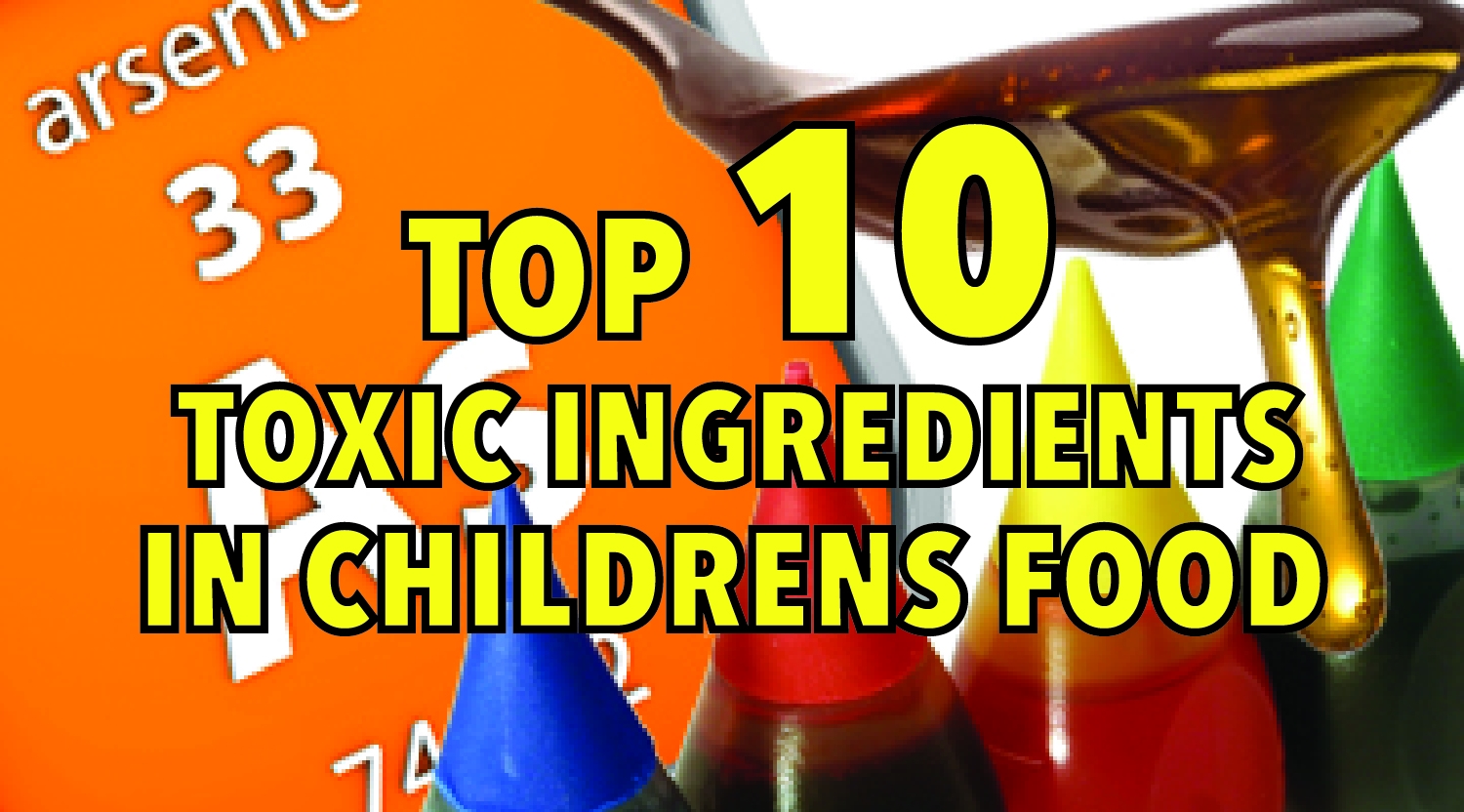Top 10 toxic ingredients in children’s food
10/09/2015 / By Greg White

What do bisphenol-A , high-fructose corn syrup and propylene glycol have in common? They are all toxins that can be found in food marketed to children — and you could be inadvertently purchasing them.
One of the best gifts that parents can bestow upon their children is a nutritious diet. Yet many foods on supermarket shelves bestow just the opposite. Many parents purchase these toxins, either because the toxins aren’t listed or worse — the brands are listed as “natural” and “healthy.”
It is crucial that children receive a nutritious diet to foster developmental growth. Consider the following a grocery list of toxins to avoid next time you go to the supermarket.
1. Bisphenol-A (BPA)
BPA is a chemical linked to a variety of health problems including cancer, diabetes and heart disease. It’s old news that BPA can be found in processed foods, but you might be surprised which foods. A 2011 study from the San Francisco-based Breast Cancer Fund found BPA in six canned foods marketed to children, including the brands Campbell’s, Chef Boyardee, Annie’s and even Earth’s Best Organic. The amount of BPA detected in these foods is alarming, since BPA is associated with brain and hormone development problems in children.
2. High-fructose corn syrup (HFCS)
HFCS is in nearly everything, including beloved childhood foods. Prominent examples include Kellogg’s breakfast cereals, Nabisco Oreo cookies, Campbell’s vegetable soup and Oscar Mayer Lunchables. HFCS is derived from corn and is used as a sweetener. HFCS is a associated with an increased risk for diabetes and is a major reason why people are for the first time in human history simultaneously malnourished and obese.
The power of the elements: Discover Colloidal Silver Mouthwash with quality, natural ingredients like Sangre de Drago sap, black walnut hulls, menthol crystals and more. Zero artificial sweeteners, colors or alcohol. Learn more at the Health Ranger Store and help support this news site.
3. Arsenic
Arsenic has been recognized as a poison in water for quite some time, but many people are worried it’s in fruit juices marketed to children too. An investigative study by Consumer Reports found that five fruit juice brands had arsenic levels which exceeded federal drinking water standards. Most of the arsenic found in the study was inorganic. Arsenic has been used as a preservative for pressure-treated lumber in children’s playground equipment. Now, it’s used for their juice.
4. Food dyes
Food dyes are widely used, dangerous additives that can be found in a variety of food marketed to children, including cereal, candies, desserts and beverages. There are nine different colors that are allowed by the FDA. According to a report published in The Lancet, artificial food dyes increase the risk of hyperactivity in children, as well as food allergies and cancer. In addition, moderate doses have been linked to the occurrence of tumors in rats. When shopping, look for natural food products that don’t have artificial flavors.
5. Phosphoric acid
Phosphoric acid is an odorless liquid added to children’s drinks to help slow the growth of bacteria; otherwise, the bacteria would rapidly multiple due to all the sugar in the drinks. Although phosphoric acid is added as a preservative, it can erode children’s teeth and even soften bones. According to a report published in General Dentistry, soda with phosphoric acid is about as good for teeth as battery acid.
6. Monosodium glutamate (MSG)
MSG is a “flavor enhancer” commonly used in soups, crackers, potato chips and canned vegetables. It can also be found in school cafeterias and baby formula. Foods with MSG include Campbell’s SpaghettiOs and Chicken Noodle Soup, as well as packaged dinners. Many adverse reactions have been linked to MSG, including obesity, headache, fatigue and depression. According to 2010 study published in the journal Obesity involving 752 healthy Chinese people ages 40–59, researchers found that MSG consumption positively correlates to weight gain. Weight gain was greater in participants who consumed MSG than those who did not consume MSG. Keep an eye out for MSG when shopping, since it is often not labeled.
7. Aspartame
Aspartame is one of the most common artificial sweeteners used in diet sodas, but it can also be found in cereals, yogurts, cooking sauces and chewing gum. It also happens to be one of the most dangerous additives in food today. Aspartame accounts for approximately 75 percent of the adverse reactions to food additives reported to the FDA. Whenever aspartame is ingested, it converts into formic acid — a formaldehyde-related poison found in the venom of fire ants. The number of health problems attached to aspartame boggles the mind. Examples include migraines, rashes, weight gain, heart palpitations and depression. Furthermore, aspartame can worsen pre-existing conditions, including brain tumors, seizures, diabetes, Parkinson’s disease and epilepsy.
8. Sodium nitrite
Sodium nitrite is a preservative found in beloved childhood lunch meats, including hot dogs, ham and salami. Sodium nitrite shouldn’t be conflated with sodium nitrate, which is a naturally occurring form of nitrogen found in soil. Sodium nitrite is an inorganic compound that splits healthy cells into cancer cells. In a study from the University of Hawaii with almost 200 people, participants who ate processed meat were 67 percent more at risk for pancreatic cancer than people who didn’t consume, or didn’t consume as much, processed meats. After following the participants for seven years, the researchers identified sodium nitrite as the cancer-causing agent behind processed meat.
9. Sodium benzoate
Like sodium nitrite, sodium benzoate is a preservative crafted by manufactures to prevent spoilage. It can be found in sauerkraut, jellies, shredded cheese, fruit juices and hot sauce. Benzene is a chemical linked to an increase risk for leukemia and blood cancers. Benzene isn’t in sodium benzoate, but it can surface whenever sodium benzoate is mixed with ascorbic acid, such as vitamin C. The carcinogen starves the cells of oxygen, making them less resistant to cancer.
10. Bovine growth hormone (rBGH)
RBGH is a genetically engineered hormone injected into dairy cows to increase milk production. It is banned in Europe and Canada for its carcinogenic effects and has been boycotted by 95 percent of dairy farmers. Nevertheless, it continues to be used in the United States. Apart from dairy products marketed to children, rBGH is found in burger patties made from rBGH-treated cows. The FDA has admitted that rBGH increases the risk of reproductive problems, digestive disorders and laceration in cows. In recent years, their has been growing concern that rBGH may be related to the early onset of puberty in girls.
The listed toxins increase the lifespan of food and shorten the lifespan of children. Many of the listed toxins aren’t required by the FDA to be labeled. Fortunately, you can use this list as a reference for which ingredients to avoid in order to help your children develop into healthy adults.
Sources include:
ConsumerReports.org[PDF]
Tagged Under: arsenic, artificial colors, aspartame, Big Food, BPA, cancer, children's food, food additives, food chemicals, food marketing, MSG, obesity, preservatives, toxic ingredients




















